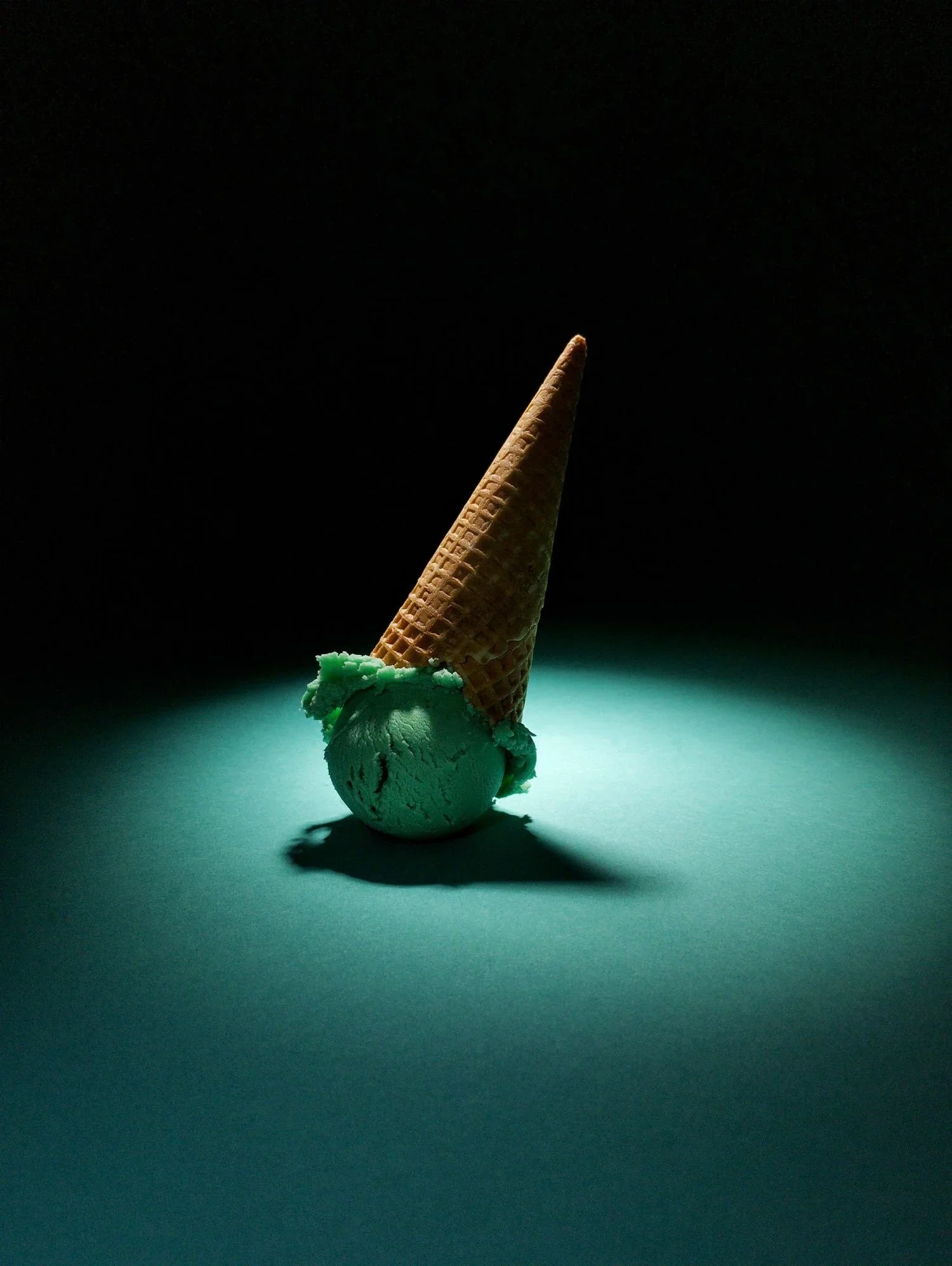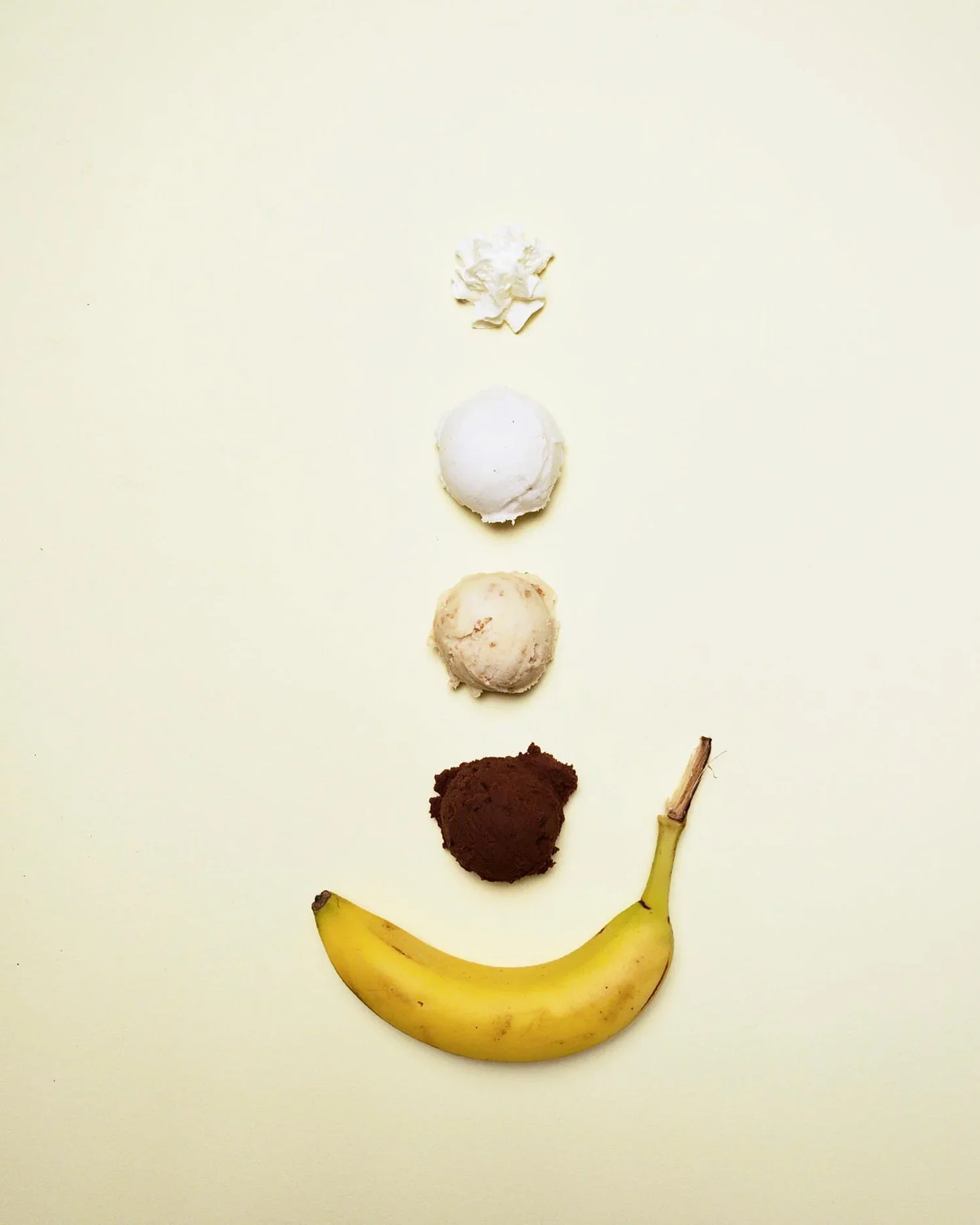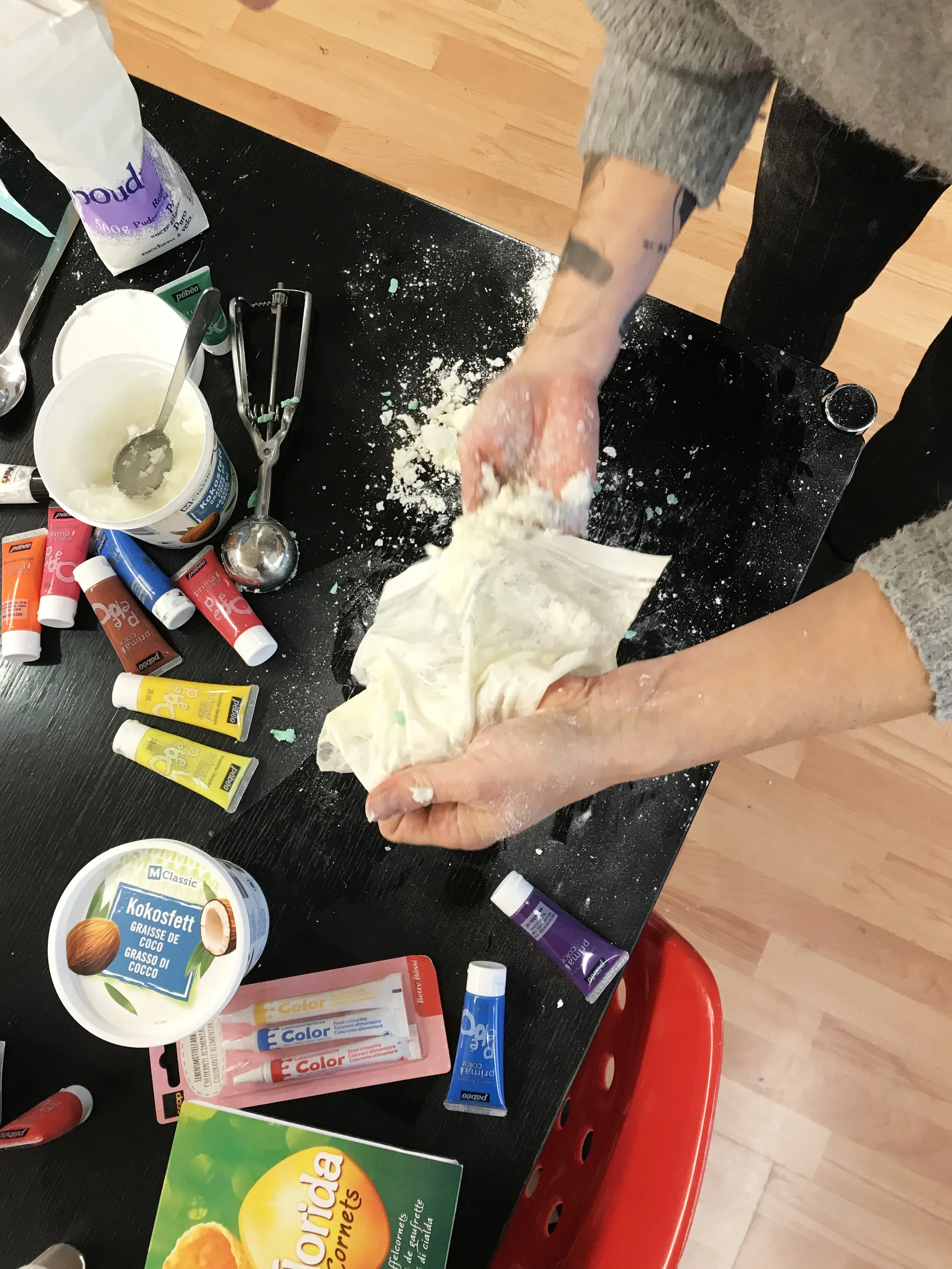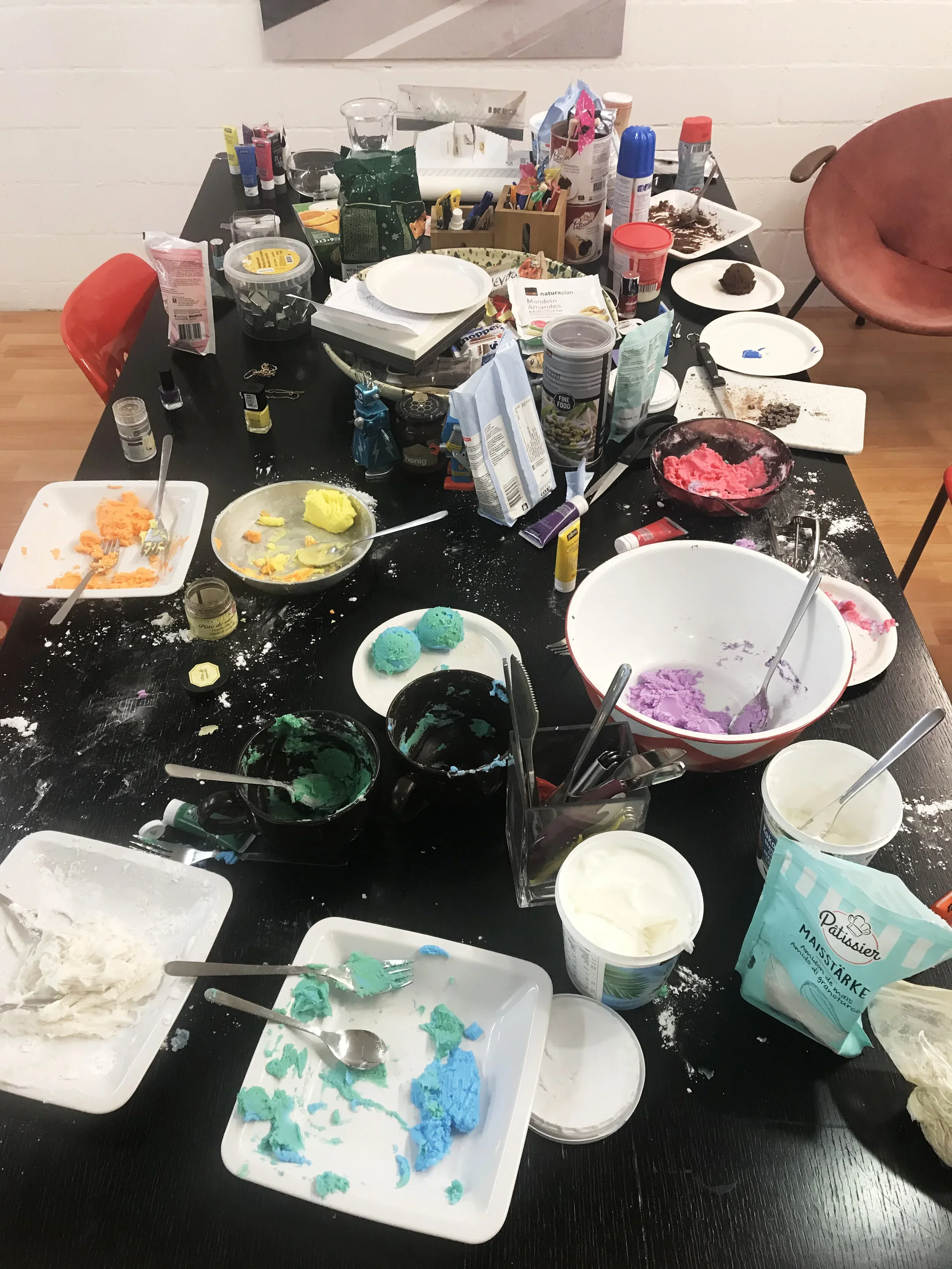Collaboration Instead of Competition: About Smartphones and Fake Ice Cream
Hello dear readers,
A few weeks ago, I wrote a post about my projects. Today, I’d like to share something about collaborative projects. Well, wrapped up in topics like smartphone photos and ice cream.
If you follow me on social media, you might have noticed that my studio partner, Barbara Hess, and I teamed up to realize a fun project together.
It all started when we wondered how to lighten the load of our heavy photo equipment. There can be quite a lot of flash units, tripods, cameras, lenses, cable reels, and diffusers to carry around. I’ve already written a blog about what’s inside my photo backpack. Recently, we treated ourselves to a Profoto C1, a small flash, about the size of a tennis ball, with the power of a large flash unit. Then Barbara mentioned that many photographers nowadays shoot with smartphones. Shouldn’t we give that a try instead of dismissing it as “unprofessional”? Can we create beautiful images without an expensive DSLR?
What should we photograph with the phone? For two dessert lovers, the answer was obvious: ICE CREAM! Last year, I already photographed real ice cream and realized how quickly it melts and how tricky it is to shoot. So I suggested we make fake ice cream instead. One thing led to another, and we ended up working on basically two projects.
Smartphone Photos:
Using two Profoto flash units (one small, one even smaller), we could comfortably control everything via the Profoto app on the smartphone. Both the flashes and the camera settings are adjustable through the app. It’s worth noting that phone cameras are usually wide-angle, which can cause some distortion. Overall, though, I was pleasantly surprised. I wouldn’t shoot all my assignments with a phone, I love my camera too much, and for some projects, a phone just isn’t enough. But depending on the project and client, I see it as an exciting alternative. Especially today, when many images are made for social media anyway. We’re all used to the look of phone photos. I find it fun to get creative with it. Plus, great photos come not from the equipment but from the photographer. The final result is what counts.
Fake Ice Cream:
You’ve probably been waiting patiently for this. Here’s the recipe! There are two similar versions, but the results differ slightly. Let’s go!
Version 1
If you want fake ice cream that’s a bit firmer and won’t slide or get squished when touched, use frosting (buttercream). You can make it yourself, but I recommend buying some. It’s a bit pricey (around CHF 9 for 400g) but enough for many fake scoops. For one scoop, you’ll need about a heaping tablespoon. Then add lots of powdered sugar, at least half a pack per scoop. Knead by hand or with a mixer. Add powdered sugar and the color of your choice, little by little. You can get creative with colors, using food coloring or even gouache/acrylic paint — since you won’t eat it anyway. You can also add cocoa powder for a chocolate “ice cream.” Keep stirring and adding until you reach the right consistency. I recommend this recipe mainly for milky-looking ice cream. But be careful: once you form a scoop, you can’t reshape it later.
Version 2
This version works best for sorbets and is a bit cheaper. Same principle, but replace the buttercream with solid coconut oil. Stir the mixture with a spoon until it reaches the perfect consistency. The ingredient ratios are similar to version one. You’ll also need plenty of powdered sugar or, what worked even better for us with coconut oil, cornstarch (Maizena). This scoop can be reshaped later, which can be handy depending on your use.
I haven’t worked on a project with another photographer for a long time and enjoyed collaborating with Barbara — coming up with concepts, making fake ice cream, and working with the smartphone. Competition is not unusual in our industry, which is understandable to some degree since the photography market is constantly changing and highly competitive. But competition weakens our field. We should be able to exchange openly, share knowledge, and work together. Only in this way can we strengthen the photography community.
Until next time,
Rachel
(see images below)
Zusammenarbeit statt Konkurrenz: Von Smartphones und Fake Ice Cream
Hallo liebe Leserschaft
Vor einigen Wochen habe ich einen Beitrag zu eigenen Projekten geschrieben. Nun schreibe ich gerne einen Beitrag zu gemeinsamen Projekten - Naja, eingepackt mit Themen, wie Smartphonefotos und Eiscrème.
Wer mir auf meinen sozialen Kanälen folgt, hat vielleicht mitbekommen, dass meine Studiopartnerin Barbara Hess und ich uns zusammen getan haben, um ein witziges Projekt zu realisieren.
Es fing damit an, dass wir uns überlegten, wie wir unser schweres Fotomaterial “schlanker” halten könnten. Da kann einiges an Blitzlampen, Stativen, Kameras, Objektiven, Kabelrollen und Diffusern zusammen kommen. Ich habe bereits einen Blog über das Innenleben meines Fotorucksacks geschrieben. Kürzlich haben wir uns deshalb eine Profoto C1 gegönnt. Einen kleinen Blitzer, gross wie ein Tennisball, der die gleiche Leistung einer schweren Blitzlampe hat. Gleich darauf kam Barbara in den Sinn, dass heutzutage einige Fotografen mit Smartphones Aufträge realisieren. Sollten wir dies nicht auch versuchen, anstatt es als “unprofessionell” zu belächeln? Schaffen wir es auch ohne teure Spiegelreflexkamera schöne Bilder zu machen?
Was wollen wir nun mit dem Handy fotografieren? Für zwei Schleckmäuler lag die Antwort nahe: EISCRÈME! Ich habe letztes Jahr bereits Glacé fotografiert. Da wurde mir bewusst, wie schnell Eis schmilzt und wie mühsam dies in einem Shooting ist. Also schlug ich vor, Fake-Ice Cream zu produzieren. So führte eins zum anderen und wir arbeiteten quasi an zwei Projekten.
Smartphone-Fotos:
Mit zwei Profoto Blitzlampen (die eine klein, die andere kleiner) konnten wir bequem über die Profoto App auf dem Smartphone alles einstellen. Blitzlampen und die Kamera sind darüber bedienbar. Zu beachten ist, dass Handykameras meist weitwinklig sind, was zu Verzerrungen führen kann. Grundsätzlich bin ich aber positiv überrascht. Alle meine Aufträge würde ich nicht mit dem Smartphone fotografieren. Dafür liebe ich meine Kamera zu sehr und für gewisse Aufträge reicht mir das Handy nicht aus. Aber je nach Projekt und Kunde, sehe ich es als eine spannende Alternative. Vor allem heutzutage, wo viele Bilder sowieso für Social Media genutzt werden. Wir sind uns alle das Aussehen von Handyfotos gewöhnt. Ich finde es spannend, kreativ damit zu spielen. Ausserdem entstehen schöne Fotos nicht durch das Equipment, sondern durch die Fotografin. Das Endresultat ist das Entscheidende.
Fake-Glacé:
Darauf hast du jetzt bestimmt geduldig gewartet. Ok, hier das Rezept. Es gibt zwei Varianten, die ähnlich sind, aber das Resultat ist etwas anders. Los geht’s!
Variante 1
Benötigst du eine Eiscrème, die etwas fester in der Konsistenz ist und nicht verrutscht oder beim anfassen verdrückt wird, dann nimm am besten Frosting (Buttercrème). Die kannst du selber machen, aber ich rate dir eher eine zu kaufen. Ist zwar teuer (Ca. CHF 9.- für 400g), wird dir aber für etliche Gelatis reichen. Für eine Kugel benötigst du einen gehäuften Esslöffel. Dann nimmst du gaaanz viel Puderzucker. Für eine Eiskugel würde ich dir mindestens ein halbes Pack empfehlen. Nun kannst du dies von Hand oder in einer Rührmaschine kneten. Füge immer wieder Puderzucker und die Farbe deiner Wahl hinzu. Bei den Farben kannst du richtig kreativ werden. Entweder mit Lebensmittelfarbe oder sogar Gouache/Acryl. Essen wirst du das später sowieso nicht wollen. Du kannst auch Schokoladenpulver nutzen, um eine Schoggiglace zu kreieren. Rühre und füge alles nach und nach hinzu, bis du die richtige Konsistenz hast. Ich empfehle dieses Rezept vorallem für milchige Ice Creams. Aber aufgepasst, sobald du eine Kugel geformt hast, kannst du sie später nicht mehr ändern.
Variante 2
Diese Variante macht sich vor allem für Sorbets gut und ist auch etwas günstiger. Dasselbe Prinzip, nur ersetzt du die Buttercreme mit hartem Kokosöl. Hier würde ich die Masse mit einem Löffel rühren, bis sie die perfekte Konsistenz erreicht. Das Verhältnis der Zutaten ist gleich, wie in der ersten Variante. Also benötigst du auch hier jede Menge Puderzucker, oder, was uns beim Kokosöl noch besser schien, war Maizena. Diese Kugel kannst du später immer wieder umformen, was je nach Nutzung praktisch sein kann.
Ich habe schon lange kein Projekt mit einer/m Fotografen/in gemacht und hatte viel Freude mit Barbara an Konzepten, Eiscrèmes und mit dem Smartphone zu arbeiten. In unserer Branche ist Konkurrenzdenken nicht unüblich, was in gewisser Weise verständlich ist, da sich die Fotografiebranche konstant verändert und der Markt sehr umkämpft ist. Konkurrenzdenken schwächt aber unseren Fachbereich. Wir sollten uns ehrlich austauschen können, Wissen teilen und zusammen arbeiten. Nur so stärken wir die Fotografiebranche.
Bis zum nächsten Mal,
Rachel
Alle Fotos: ©Barbara Hess, Rachel Liechti





